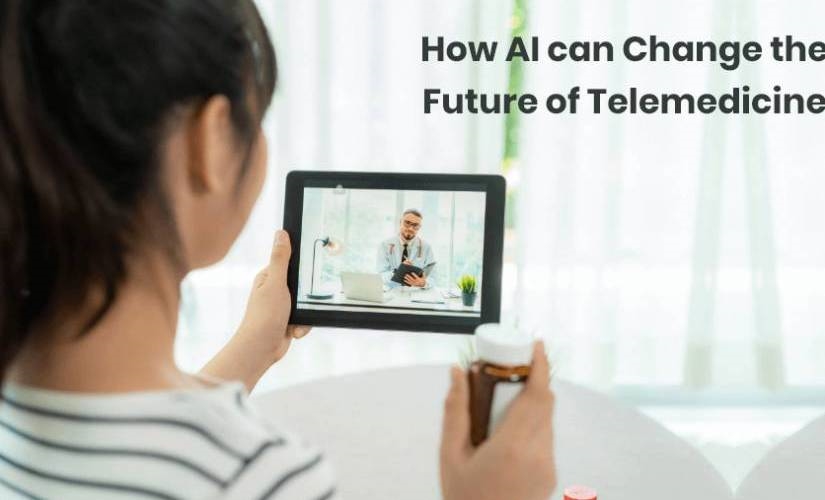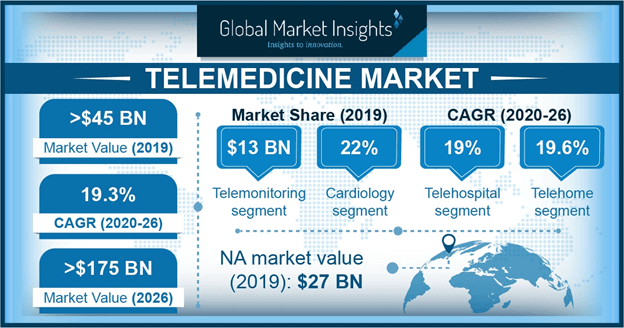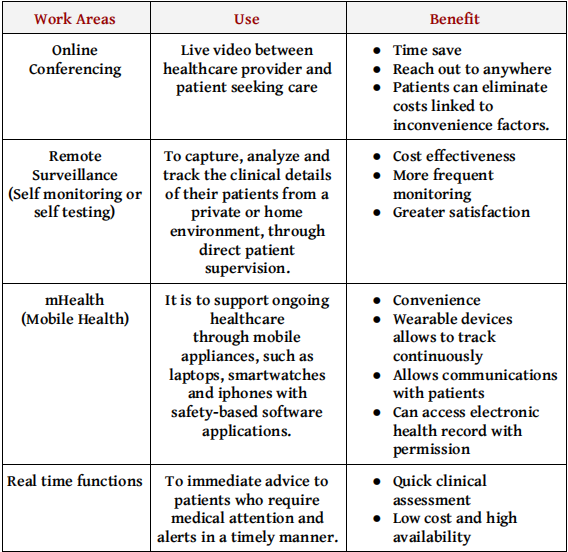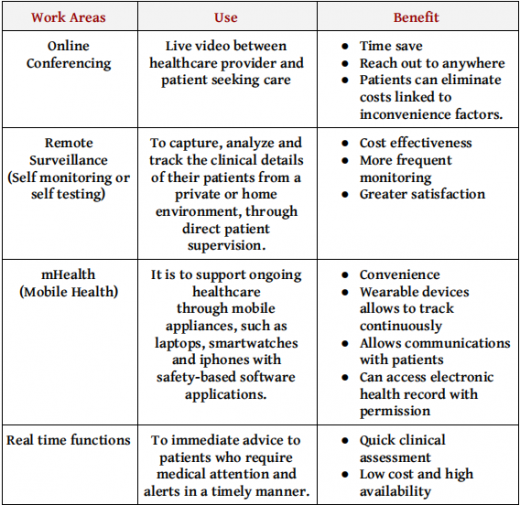How AI can Change the Future of Telemedicine
How AI can Change the Future of Telemedicine

Artificial Intelligence and telemedicine are no more diverse. It has helped the digital health industry to emerge high from the scratch. This article outlines the various work areas of telemedicine and how Artificial Intelligence can change the life of healthcare systems even with challenges over the years.
Table of contents
- Introduction
- Market and types of telemedicine
- Present and future of Artificial Intelligence in telemedicine
- Challenges of Artificial Intelligence in telemedicine
- Final words
Introduction
When in 1955, John McCarthy came up with the name “Artificial Intelligence” who had thought one day we would be diagnosing our health through the internet to distant locations?
It was a dream by then, but not anymore. The generation has adopted telemedicine rapidly – which refers to the taking care of patients remotely, without being present physically – and the increasing demand is challenging the technology every second to grow further.
However, Artificial Intelligence(AI) is the major role player in the telemedicine and healthcare systems. To make the computers more useful in fixing health care challenges and enabling the doctors to consult patients using conferencing tools is the main objective behind Artificial Intelligence in telemedicine.
Though the work areas of Artificial Intelligence are currently limited to Tele-radiology, Telepathy, Tele-dermatology, and Tele-psychiatry, it is already empowering the telemedicine in the world through different services in terms of development and execution. Look at the below stats to understand the telemedicine in detail.
Market and Types of Telemedicine
As we discussed, in recent years the demand in telemedicine has expanded substantially, the market share has increased immensely in 2019 as it was valued at approximately USD 14.0 billion in 2014.
As the chart suggests, in 2019 the telemedicine global market was valued at some 45 billion U.S. dollars. The industry is also projected to rise to more than US$ 175 billion by 2026.

In fact, various telemedicine firms are seeing a spike in simulated visits in the aftermath of the COVID-19 pandemic.
Alone, India shares 41% of respondents who tried to reach the telemedicine services by 2018, which has increased significantly in 2020.
Many factors also contributed to the growth of the market, such as increasing chronic respiratory diseases has already increased telemedicine adoption services. Patients with suspected flu-like symptoms control multiple telemedicine systems for remote access to health-care services.
Telemedicine market that largely encompasses work areas consisting of the major types as follows.
A. Online conferencing
B. Remote surveillance
C. mHealth
D. Real-time functions

These services, however, are a key step forth into providing health access to all patients who are in need, especially those living in areas where local healthcare providers are limited. Moreover, telemedicine, in contrast to conventional in-person consultations, offers a major advantage with decreased prices.
Talking about the present and future of Artificial Intelligence in telemedicine, it can be understood better through the following available possibilities.
Present and future of Artificial Intelligence in telemedicine
1. We can interpret the large data to improve the health care systems
The world has already developed the standardized electronic health record program by Artificial Intelligence to increase the huge data of patient records. Not only that, Artificial Intelligence through computer science, often provides promising opportunities to evaluate insights and new interference to further enhance health care outcomes.
As the world currently suffers from the corona pandemic and yet to develop the vaccine, telemedicine is the biggest hope as it can identify the scope and improvement of patients through the huge data availability using Artificial Intelligence and various machine learning techniques. It also increases the accuracy of the end result through large data, unlike offline laboratory records.
2. The early detection of chronic diseases made possible
The computer-assisted diagnostic support system and software can help doctors and experts identify the early symptoms of different diseases.
It also helps to minimize the economic burden by reducing the errors and can control the overall health progression. For instance, India has developed ‘Aarogya Setu’ mobile application to connect essential health services with the people of India to track the early Coronavirus symptoms of patients. However, it is yet at a basic stage, in the immediate future the data science and telemedicine can do even better with the aid of Artificial Intelligence in the specific area.
How?
The diseases such as Coronavirus and Ebola which have no treatments and vaccines, the world of telemedicine can capture the symptoms from the patients online. Providing that information to machine learning algorithms and by training the machine learning models, we can also reduce the time to develop the vaccine.
More than that, vaccines can be developed more precisely as the availability of huge data enhances the entire development in various predictions.
3. It helps to increase the automatic assistance
Clinical industries are already taking advantage of artificial intelligence in the healthcare infrastructure and successfully combating the numerous diseases. But that’s not all. In the race to grow further, also the individuals are set to participate, as proven by Apple recently, by developing the Apple Watch that can track your heart rate and able to generate an electrocardiogram without being present in the hospital. Because not all patients need treatments, but sometimes only assistance.
Artificial Intelligence can also help in the near future to control the disease like blood sugar by evaluating large data available in the area. The computer can provide drug assistance by developing artificial algorithms in the implementation of various drugs at different levels of the patient’s blood sugar.
This is, however, just the beginning of Artificial Intelligence in telemedicine as there’s a lot more to come in the near future.
But, wait. Before you conclude, there are certain questions in the pile as the challenges of Artificial Intelligence in telemedicine that are as follows.
Challenges of Artificial Intelligence in telemedicine
1. What if the doctors never look at the huge recorded data?
This is a serious concern. Millions around the world are wearing Apple Watches, Fitbits, and other devices capable of monitoring their heart rate and other biometrics that imply health care. But what if the doctors may not take urgent action from the novel sources of broad data, which tend to suggest an emergency?
All in vain.
Telemedicine, therefore, to grow further, must imply the community standards that can possibly be able to handle the large data for strong implementations.
2. Will AI replace the doctors?
Most probably not. Artificial Intelligence is progressing quickly, no doubt. It is, in fact, hyped over the last years in telemedicine. It has also helped the doctors to reduce clerical work such as typing huge data, that was taking more than half of their clinical time.
But, would Artificial Intelligence and machine learning be able to give value, empathy, and active listening to the patients as the doctors can?
No. It can not.
Artificial Intelligence, however, can be further enabled to listen to conversations for at least active listening, and probably render automated patient charts for doctors to evaluate. But it won’t replace the doctors, that is final.
3. Will everyone gets the benefit of AI in telemedicine?
For sure, the healthcare provisions online is still not easy for everyone, but it is believed that over the five years, it will get there.
But not for all. A lot of people might not be comfortable with digital consultations, while others may have a language gap or lack of devices.
Conclusion
If you conclude, Artificial Intelligence in telemedicine has come a long way already but still has a long way to go. AI has large capabilities to build far more effective and reliable healthcare if implemented successfully. The gradual growth of telemedicine with AI will also raise both human and animal life expectancy.
The post How AI can Change the Future of Telemedicine appeared first on ReadWrite.
(31)


